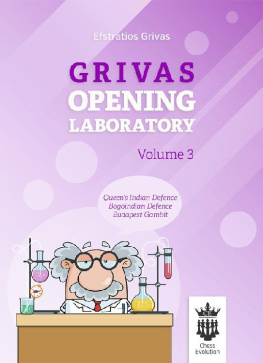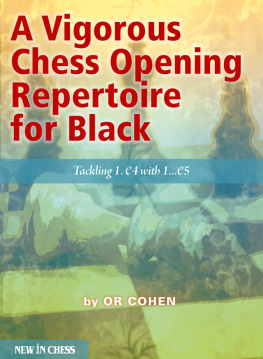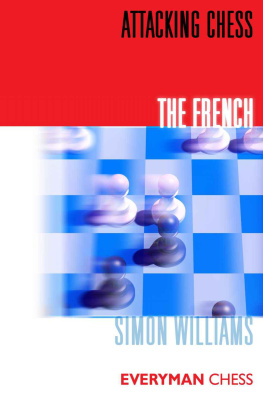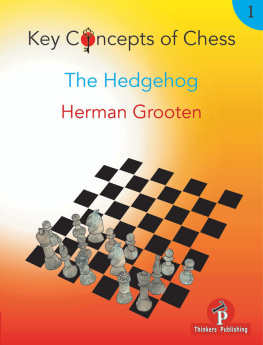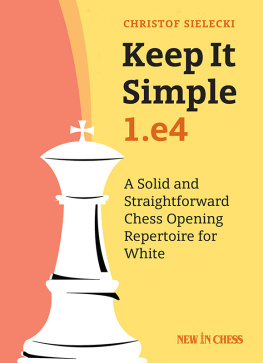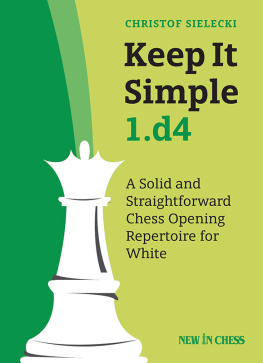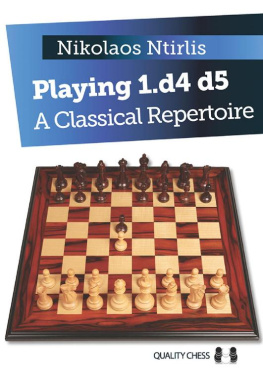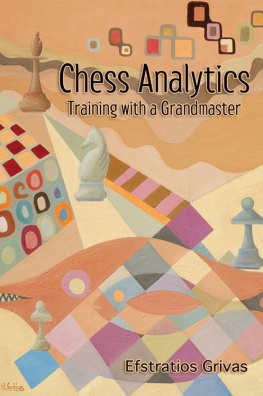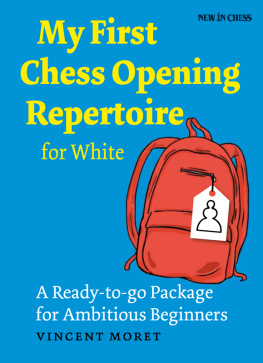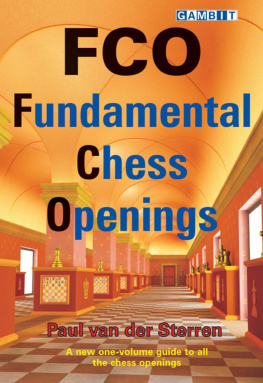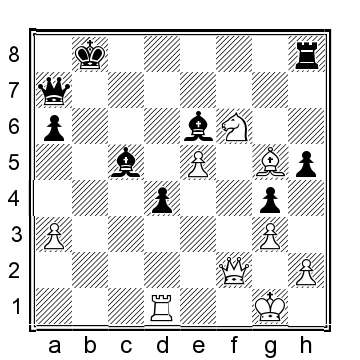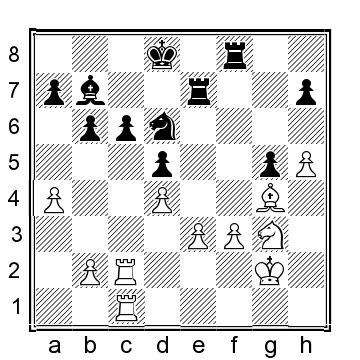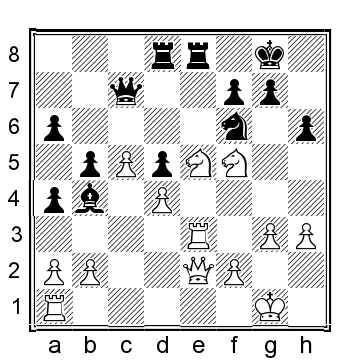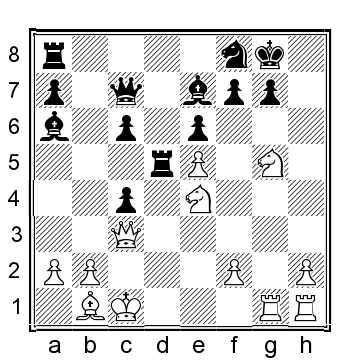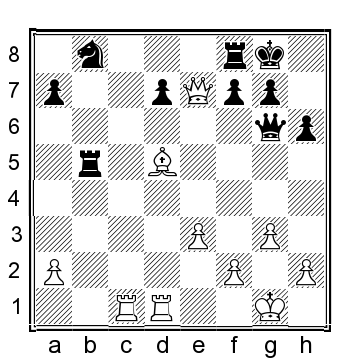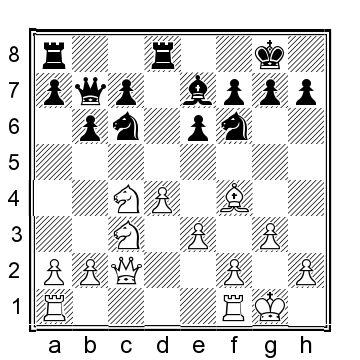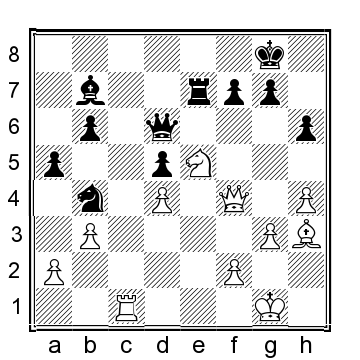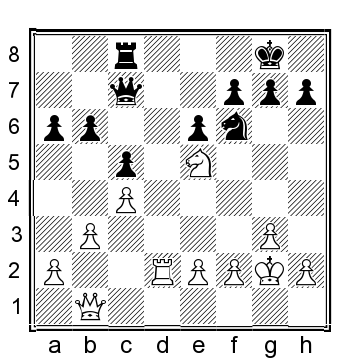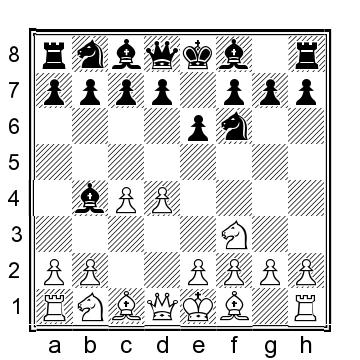Show in Text Mode Show in Quiz Mode
Chapter 5.
Tactical Motifs
Tactics are the salt & pepper of chess. They crown every strategy and appear in every game, so we cannot live without them!
Typical tactical motifs repeat themselves, and their knowledge and understanding are an essential asset to season our opening preparation.
Grivas Efstratios
Azarov Sergei
E15 Kemer 2009
1.d4 N f6 2.c4 e6 3. N f3 b6 4.g3 B a6 5. Q b3 N c6 6. N bd2 B b7 7.e4 d5 8.cxd5 exd5 9.e5 N e4 10.a3 f5 11. B b5 a6 12. B xc6+ B xc6 13. N xe4 fxe4 14. N g5 Q e7 15. B d2 h6 16. R c1 B b7 17. N h3 g5 18.f4 exf3 19. Q xf3 0-0-0 20.0-0 K b8 21. B b4 c5 22. B c3 B c8 23. N f2 B g7 24. N g4 h5 25. N f6 g4 26. Q f2 B e6 27. B d2 R c8 28. B g5 Q a7 29.dxc5 bxc5 30.b4 B f8 31. R fd1 d4 32.bxc5 R xc5 33. R xc5 B xc5
Show/Hide Solution
34. R b1+! B b6
34... K c7 35. R c1 R c8 36. N e4 K b7 37. Q c2 B f8 38. N d6+ B xd6 39. R b1++
35. N e4
35.a4! a5 36. Q b2 K b7 37. N e4+
35... R c8 36. N d6 R g8 37. B d2 K c7 38. Q f6 d3+ 39. K f1 K d7 40. R b4 Q a8 41. R xb6 Q h1+ 42. K f2 Q xh2+ 43. K e3 Q xg3+ 44. K d4 Q g1+ 45. B e3 d2 46. B xg1 d1= Q + 47. K c3 Q e1+ 48. K c2 Q e2+ 49. K c3 Q e1+ 50. K c2 Q e2+ 51. K c3 Q e1+ 52. K c2 Q e2+
Gyimesi Zoltan
Sax Gyula
E15 Szekesfehervar 2006
1.d4 N f6 2.c4 e6 3. N f3 b6 4.g3 B a6 5. Q b3 N c6 6. N bd2 d5 7. Q a4 B b7 8. B g2 Q d7 9.cxd5 exd5 10.0-0 B d6 11. N b1 N e5 12. Q xd7+ N exd7 13. N c3 c6 14. B f4 B xf4 15.gxf4 K e7 16. R ac1 R hd8 17. R c2 N e8 18. N e5 f6 19. N xd7 R xd7 20. R fc1 N d6 21. N d1 N b5 22.e3 R g8 23. N c3 N d6 24. N e2 N b5 25.a4 N d6 26. N g3 g6 27.h4 R b8 28.h5 g5 29.fxg5 fxg5 30. B f3 R f8 31. K g2 K d8 32. B g4 R df7 33.f3 R e7
Show/Hide Solution
34. R xc6! N c4
34... B xc6 35. R xc6 R f6 36.e4
35. R 6xc4 dxc4 36.e4 R c7 37.d5 a6 38. N f5 B c8 39. N d4 B xg4 40.fxg4 R e8 41. K f3 K d7 42. N f5?
42. K e3! K d6 43. N f3 ( 43. N c6 R xc6 44.dxc6 b5 ) 43...h6 ( 43... R f8 44. N xg5 ) 44. K d4
42... R c5 43. N g7 R e7 44. N e6 R xe6 45.dxe6+
Fominyh Alexander
Sokolov Andrei
E15 Elista 1996
1.d4 N f6 2.c4 e6 3. N f3 b6 4.g3 B a6 5. Q b3 N c6 6. B d2 Q c8 7. B g2 N a5 8. B xa5 bxa5 9.0-0 B e7 10. N bd2 0-0 11.e4 d5 12.exd5 exd5 13. R fe1 B b4 14.c5 c6 15. Q c2 h6 16. R e3 B b5 17. N h4 Q g4 18. N df3 a4 19.h3 Q d7 20. N e5 Q c7 21. N f5 R ad8 22. B f1 R fe8 23. B xb5 cxb5 24. Q e2 a6
Show/Hide Solution
25. N g4! N xg4
25... R xe3 26. N xf6+ gxf6 27.fxe3+
26. R xe8+
Ipatov Alexander
Zhigalko Sergei
E15 Cappelle-la-Grande 2011
1.d4 N f6 2.c4 e6 3. N f3 b6 4.g3 B a6 5. Q b3 c6 6. B g5 B e7 7. N c3 h6 8. B xf6 B xf6 9.e4 d6 10.e5 dxe5 11.dxe5 B e7 12. N e4 0-0 13. Q c3 N d7 14.0-0-0 Q c7 15. B d3 R fd8 16. B b1 N f8 17. R dg1 b5 18.g4 bxc4 19.g5 hxg5 20. N fxg5 R d5
Show/Hide Solution
21. Q f3
21. N xf7! K xf7 22. N d6+ B xd6 ( 22... K g8 23. R xg7+ K xg7 24. R g1+ K h6 25. Q h3+ B h4 26. Q xh4# ) 23.exd6 Q xd6 24. R xg7+ K e8 25. Q f6+
21... B xg5+ 22. R xg5 N g6 23. R hg1 R xe5 24. N f6+! K f8 25. R xg6! fxg6 26. N d5+ Q f7 27. Q a3+! c5 28. Q xc5+ K g8 29. N e7+ K h8 30. Q xe5 Q xe7 31. B xg6 Q h4 32. R g5
Karpov Anatoly
Gavrikov Viktor
E16 Moscow 1988
1.d4 N f6 2.c4 e6 3. N f3 b6 4.g3 B b7 5. B g2 c5 6.d5 exd5 7. N h4 b5 8.0-0 bxc4 9. N c3 B e7 10. N f5 0-0 11. N xe7+ Q xe7 12. B g5 h6 13. B xf6 Q xf6 14. N xd5 B xd5 15. Q xd5 N c6 16. Q xc4 Q xb2 17.e3 R ab8 18. Q xc5 R b6 19. R ad1 N b8 20. B d5 Q b5 21. Q c7 Q a6 22. R c1 Q a5 23. R fd1 R b5 24. Q d6 Q b6 25. Q e7 Q g6
Show/Hide Solution
26. B e4! Q e6 27. B h7+! K xh7 28. Q xf8 Q xa2 29. Q d6 a6 30. Q d3+ f5 31. R b1 Q e6 32. R xb5 axb5 33. Q xb5 N c6 34. R d5 K g6 35. Q c5 Q e4 36. R d6+ K h7 37. Q d5 Q b1+ 38. Q d1 Q e4 39. Q d3 Q g4 40. R d5
Belavenets Sergey Vesevolodovi
Botvinnik Mikhail
E18 Moscow 1934
1.d4 N f6 2.c4 e6 3. N f3 b6 4.g3 B b7 5. B g2 B e7 6.0-0 0-0 7. N c3 d5 8. N e5 Q c8 9. B f4 dxc4 10. N xc4 B xg2 11. K xg2 Q b7+ 12. K g1 R d8 13. Q c2 N c6 14.e3
Show/Hide Solution
14... R xd4! 15.exd4 N xd4 16. Q c1
16. Q a4 N f3+ 17. K h1 ( 17. K g2? N e1+ 18. K h3 Q g2+ 19. K h4 N f3# ) 17...e5! 18. B e3 a6 ; 16. Q d1 N f3+ 17. K h1 R d8
16... N f3+ 17. K h1 e5 18. B e3 N g4
18... R d8! 19.h3 R d3
19. Q c2 N d2+ 20. K g1 N f3+ 21. K h1 N d2+ 22. K g1 N xc4 23. B c1 Q f3 24. Q e2 Q xe2 25. N xe2 e4 26.b3 N ce5 27.h3 N f3+ 28. K g2 N ge5 29. B e3 f5 30. R fd1 K f7 31. B d4 N d3 32. B c3 R d8 33. K f1 B d6 34. N c1 N c5 35. N e2 N d3 36. N c1 N xc1 37. R axc1 g6 38. B b2 K e6 39. K e2 c5 40. R c2 R g8
Ehlvest Jaan
Burnett Ronald
E19 Hendersonville 2007
1.d4 N f6 2.c4 e6 3. N f3 b6 4.g3 B b7 5. B g2 B e7 6. N c3 0-0 7.0-0 N e4 8. Q c2 N xc3 9. Q xc3 B f6 10. Q c2 d5 11.cxd5 exd5 12. B f4 N a6 13. R fd1 Q e7 14.h4 h6 15. R ac1 R fe8 16.e3 c5 17.b3 N b4 18. Q d2 a5 19. B e5 B xe5 20. N xe5 cxd4 21.exd4 R ac8 22. B h3 R xc1 23. R xc1 Q d6 24. Q f4 R e7
Show/Hide Solution
25. N g6! Q xg6 ( 25... Q xf4 26. N xe7++ ) 26. B f5 Q f6 27. Q b8++
Andersson Ulf
Stefansson Hannes
E19 Havana 2001
1. N f3 N f6 2.c4 b6 3.g3 B b7 4. B g2 e6 5.0-0 B e7 6. N c3 0-0 7.d4 N e4 8. Q c2 N xc3 9. Q xc3 c5 10.b3 B f6 11. B b2 d6 12. R ad1 Q e7 13. R d2 N d7 14. Q c2 R ac8 15. Q b1 R fd8 16. R fd1 a6 17.dxc5 dxc5 18. B xf6 N xf6 19. N e5 B xg2 20. K xg2 R xd2 21. R xd2 Q c7
Show/Hide Solution
22. Q d3! h6
22... Q xe5? 23. Q d8++
23. Q d6! Q b7+
23... Q xd6 24. R xd6 R b8 25. R c6
24.f3 b5 25. K f2 bxc4 26. N xc4 N d5 27.e4 N c3 28. Q b6 Q xb6 29. N xb6 R c6 30. N c4 R c8 31. K e3 R b8 32.h4 h5 33. N e5 R c8 34. R c2 N b5 35. N d3 R d8 36. R xc5 N d4 37. N b4
PART 2.
The BogoIndian Defence (E11)
The BogoIndian Defence is an opening defined by the moves 1.d4 N f6 2.c4 e6 3. N f3 B b4+
The BogoIndian Defence is named after Efim Dmitriyevich Bogoljubow (Russian: April 14, 1889 to June 18, 1952), who was a Russian-born German Grandmaster. He won numerous events and played two matches against Alexander Alekhine for the World Championship.
As in the other Indian defences, Black attempts to control the centre with pieces in hypermodern style, instead of occupying it with pawns in classical style.
Next page
